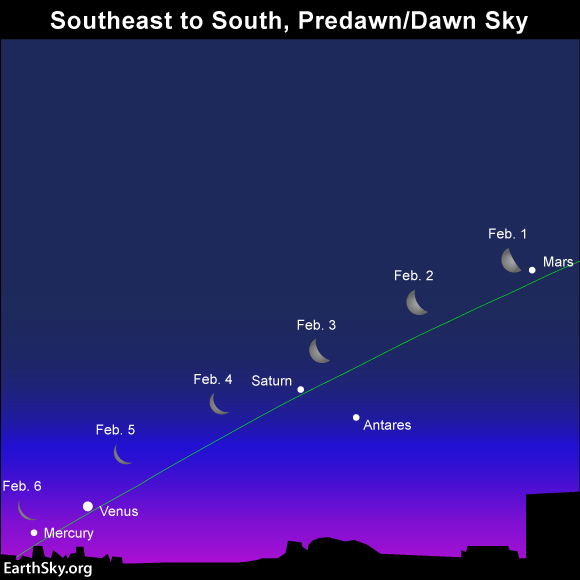The time is ripe for catching all five visible planets in the morning sky. All five bright planets are now appearing in the same sky for the first time since the year 2005. Get up 80 minutes or so before sunrise to see five planets stringing across the great vault of the morning sky.
Tomorrow morning, on Sunday, January 31, let the waning moon guide you to the ruddy planet Mars and the sparkling blue-white star Spica. (See sky chart below.) On Sunday, January 31, the lit side of the moon points in the direction of Mars while the dark side points toward Spica. By the way, if you have difficulty distinguishing the color of Mars from Spica with the eye alone, try your luck with binoculars.

View larger. | The moon is now beginning its sweep past 5 planets – and also some bright stars – in the early morning sky. Look for the moon and Jupiter late and night January 27 and in the early morning of January 28. Watch for Mars near the moon on the morning of February 1. See photos of the 5 planets, from the EarthSky community.
By visible or bright planet, we mean any planet in our own solar system that’s easily viewed without an optical aid and that has been watched by our ancestors since time immemorial.
Refer to the sky chart below, which covers a wide expanse of sky. Once you find the moon, Mars and Spica, go on from there to locate the brilliant planet Jupiter to the west (right) of Mars and Spica. Then look for dazzling Venus, the most brilliant planet of them all, to the east (lower left) of Mars. Saturn is found roughly midway between Venus and Mars, and the elusive planet Mercury sits below Venus, pretty much on line with Venus and Saturn.

View larger. | Beginning around January 20 – through mid-February – you can see five bright planets at once in the predawn sky.
Mercury, the solar system’s innermost planet, is by far the most difficult planet to spot. But you can do it! About 80 to 60 minutes before sunrise, draw an imaginary line from Saturn through Venus to seek for Mercury rather close to the horizon. Given clear skies and good seeing conditions, you can see Mercury with the eye alone. But binoculars always come in handy for any Mercury quest, especially since the sky is often murky near the horizon. Good luck!
Over the following week, the moon will be traveling eastward relative to the background stars and planets. Let the moon continue to show you the morning stars and planets from now through the first week of February. See the sky chart below.

View larger. | Keep watching in early February, as the moon sweeps past Saturn, Venus and Mercury. The green line represents the ecliptic – path of the sun, moon and planets across the sky’s dome.
Read more: See all 5 planets at once!
While the time is at hand, see all five visible planets in the morning sky. Given clear skies, all five planets should be yours to behold for another couple weeks.
